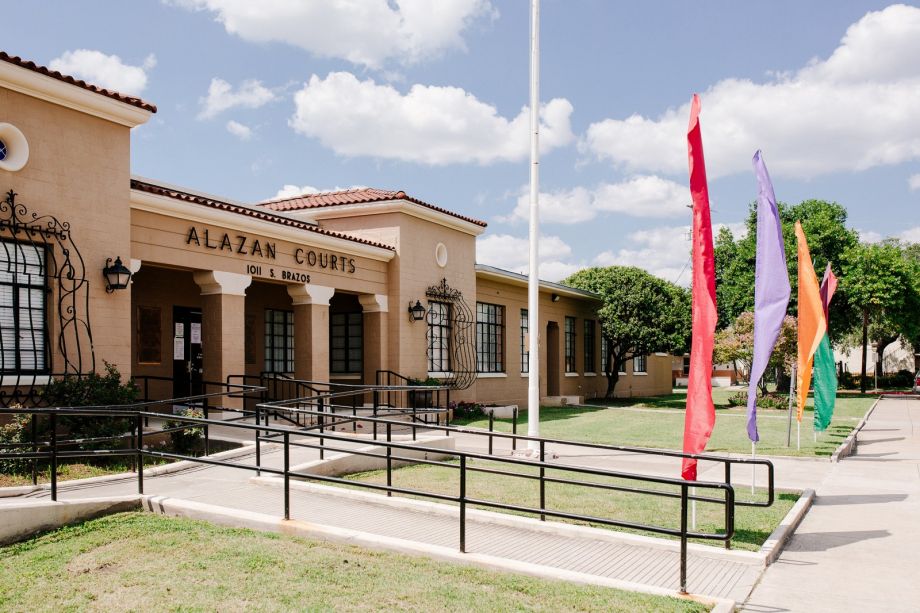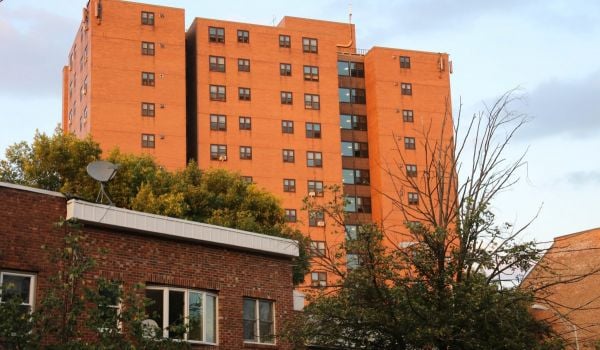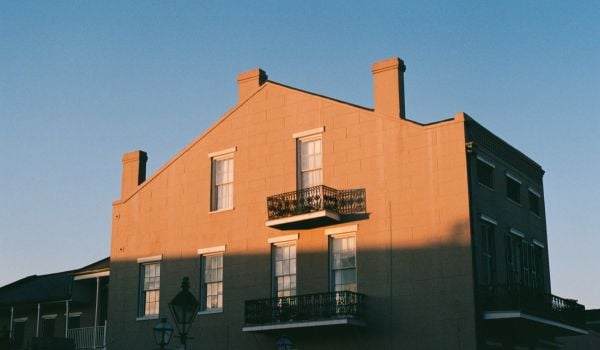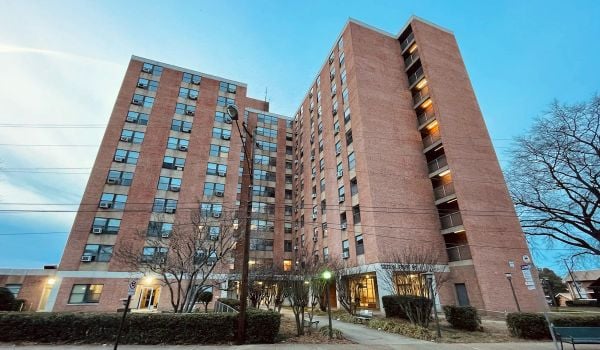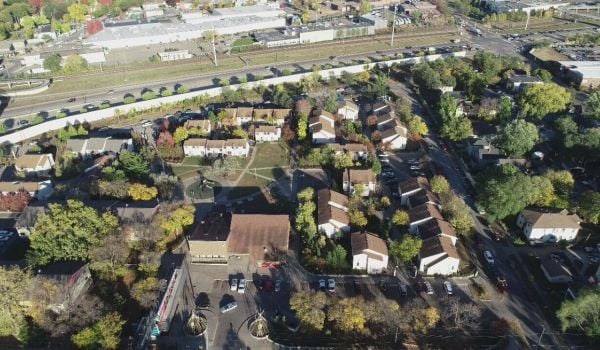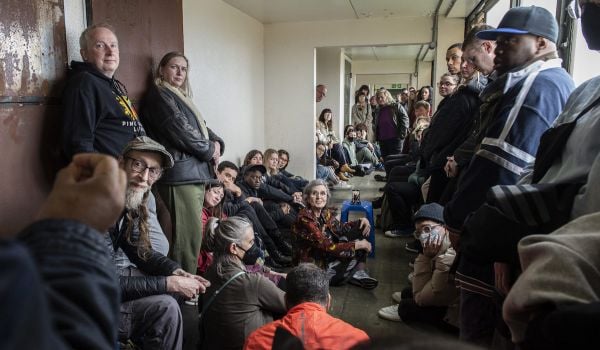For the last several years, the San Antonio Housing Authority has been planning a project that would see the Alazán-Apache Courts, the city’s oldest public housing complex, demolished and replaced with mixed-income housing. The plan was controversial for several reasons. Residents feared that they wouldn’t be able to afford to return to the complex after it was rebuilt, and that they wouldn’t be able to find other affordable apartments elsewhere in San Antonio, even with housing vouchers. And some advocates have said that the project could swiftly gentrify San Antonio’s West Side. Last fall, the National Trust for Historic Preservation listed the Alazán-Apache Courts on its annual list of “most endangered places.” Residents protested the plan as recently as January.
Then, after the housing authority’s executive director left for a position in Denver, the authority changed course. Instead of partnering with private developers to redevelop the courts as a mixed-income community, it committed to keeping all of the public-housing units that exist onsite. Most of the units will still be demolished and replaced over time, but the replacement units will be public housing, owned and operated by the housing authority, rather than privately owned apartments rented to voucher holders. The San Antonio Housing Authority’s interim president and CEO, Ed Hinojosa, Jr., recently spoke with Next City about why the group decided to commit to keeping Alazán-Apache Courts intact as a public housing community, and how attitudes toward public housing are evolving. The conversation has been edited for clarity.
The San Antonio Housing Authority had been planning for a few years to demolish the Alazán-Apache Courts and replace them with mixed-income housing. Before we talk about how that plan has changed, can you tell me why the authority was pursuing that plan in the first place?
_(1)_920_1378_80.jpg)
Ed Hinojosa, Jr. (Photo courtesy San Antonio Housing Authority)
The property was built around 1940, and the units are functionally obsolete by today’s standards. The units are small. It’s cinder block construction, uninsulated. And of course, during the time period when they were built, air conditioning wasn’t a priority. We’ve gone in and retrofitted the apartments with air conditioning, but it’s window units, not central air. The infrastructure is very dated. We have lots of plumbing issues. The electrical system is outdated. So it really needs to be upgraded to give people the amenities that we all enjoy today.
That plan was in the works for a couple years. Was it difficult to walk away from it? And why did you choose to go a different direction?
We were still in the planning phase and we had a request for proposals that was open, and we were in conversation with a developer for 18 months or so, and we were also in conversation with the community. There was quite a bit of concern about the levels of income our families have at Alazán. We have 213 families out of 500 that earn less than $150 a week. We have almost 40 families that earn less than $60 per week. Almost 450 families out of the 500 are what we call extremely low-income, so they’re at 30 percent of Area Median Income or below. And we have almost 300 out of 500 families that are in arrears in rent.
So really, the approach when you do mixed-income development is that you offer these families a voucher or you offer to move them to another public-housing location. As we started looking into the details, it’s hard for tenants to use their vouchers right now because there aren’t a lot of units available. Because of COVID and the economic situation, people aren’t moving. So there’s a low availability of units. Plus, landlords have policies that are more restrictive than public-housing policies. For example, someone that’s only earning $100 a week is probably not going to have very good credit, and many landlords check credit history. As another example, many landlords check to see if tenants have arrears with other landlords, and if they do that’s disqualifying for them to lease an apartment. And we have 300 families at Alazán that are in arrears in rent payments. So we started becoming concerned about the ability to move so many people out of Alazán and for them to find housing. So that really led us to start thinking about a different approach.
Can you tell me about that new approach?
We’re still going to redevelop it, but we’re going to do it in much smaller phases, maybe 50 units or 60 units at a time. We have a property we’re building now that will have 40 units of public housing available at the same location, called Alazán Lofts. Those units will be available by the end of this year or early next year. We’re looking at maybe building some additional units at a baseball field we own within the Alazán complex. This would allow us to move somewhere between 50 and 70 people into new apartments but within the Alazán property. And then as we move those people, we could redevelop their section of Alazán and rebuild it and do sort of a cascade of movement through the rest of the property. So we’re still planning to redevelop but we’ll do it in much smaller increments, with the goal of keeping families within the Alazán complex.
How did residents’ advocacy affect that decision? There were some protests about the old plan.
Yes, there were protests about the old plan. I think as we started looking into the demographics of our residents and the current rental-market situation, which actually has changed quite a bit in the last year because of the pandemic, all of that really went into our thinking.
A lot of housing authorities pursue mixed-income projects instead of directly replacing public housing units. Why is that attractive from a funding standpoint?
It’s been the common practice for about 20 years, maybe a little bit more. And the reason is it generates tax-credit equity that can be invested in the property. That helps fund the actual reconstruction. The way it works is tax credits are allocated to different developers and housing authorities, and those tax credits are sold to investors. And the income from that sale is used to help finance the property.
Is this version of the plan going to be much more difficult to fund?
Yes, it will be more difficult to fund. One of the approaches we’re looking at is, we have land at the baseball field, so we could start building there, but we also have vacant land that we own in other parts of the city. So one approach is taking some of that land, selling it, and using the proceeds to redevelop Alazán. That’s under consideration.
What’s the difference between the cost of this plan versus the mixed-income plan?
In some ways the mixed-income plan that involves tax credits is, in total, more expensive, because there are many consultants and professional fees associated with it. Here in Texas, a typical tax-credit deal costs around $5 million more than a straight construction. So there’s that cost associated with it. The question on redevelopment is if we do it ourselves, how are we going to fund it? And we’re just now beginning to evaluate our options. Fortunately we are in a strong financial position, so we do have some options.
Why has it been so difficult to get federal funding to just keep up with the maintenance of public housing in the U.S.?
This has been a trend for at least 25 years. It started in the 1990s when there was pretty high negative sentiment against public housing. That’s when this structure of tax-credit redevelopment was envisioned. And since that time, over the last 20 years, public housing has been severely under-funded. I think the intention was to create incentives for housing authorities to find a way to replace their public housing with other types of housing and mixed-income communities. It’s just been I think in the last year, maybe two years, that the conversation nationally has begun to shift. And we’re seeing on a national level and also a local level that there’s much more interest in preserving public housing, and much more interest in providing funding to address the deferred maintenance at public housing.
We’re very hopeful that the new infrastructure bill that’s already being discussed in Washington will include additional funding for public housing, both infrastructure and capital and operating funds. That’s the situation we see today. It’s a very different outlook from what it was a year ago.
Part of that trend in the 1990s was that there was a law passed which said that housing authorities no longer had to replace, 1-for-1, each of the units that they demolished. But you’ve committed to doing that at Alazán-Apache Courts. Why do you want to preserve all those units even if you don’t legally have to?
We have a waitlist of about 40,000 people that need housing and we have about 20,000 public housing units and vouchers that we can offer. So there’s a tremendous need in our city. We’ve come to the realization that San Antonio really needs more public housing, not less.
I hear you talking about the way the conversation has changed in the last year or two about the value of public housing and the need to preserve it. But the federal government still hasn’t actually made any commitments. Do you feel like you’re taking a leap of faith that the federal government will deliver on the promise of more funding?
It’s really interesting how the conversation has changed over the last year. A year ago, nobody was talking about moratoriums on evictions. Nobody was doing Zoom calls. Our world has completely changed since then. And the industry groups we belong to are helping drive the conversation by tying it with other social justice issues that need to be addressed, whether that’s healthcare justice or criminal justice reform or housing reform. We see all of these issues as very closely linked. So the conversation is changing in the background, even though nothing has actually been passed yet. It was just a year-and-a-half ago that Senator Bernie Sanders and Congresswoman Alexandria Ocasio-Cortez introduced the Green New Deal for Public Housing, and those conversations are very much happening today.
For a couple decades, like you talked about, it’s been the mindset of, basically, attrition, that there was going to be a slow reduction of the total amount of public housing. That trend has been in place much longer than the recent change in discussion. How hopeful do you feel that a reversal of that trend could come to pass in the next few years?
I think change sometimes happens very quickly, as it did with the eviction moratorium. It’s been over twenty years that housing authorities have been reducing their inventory of public housing, and it’s been a total of about 250,000 units that have been removed across the U.S. But sometimes change comes quickly, and I think particularly with the pandemic and the economic crisis and the recognition of a need for infrastructure investment in our country that it’s possible. The conversations have changed. I’m much more optimistic about funding today than I would have been a year ago.
Do you think other housing authority leaders are in the same mindset, that if the money is available to maintain and potentially expand public housing that they would want to? Or do you think there’s a lot of folks who still believe ideologically in slowly rolling down the amount of public housing?
I think that many people still believe that mixed-income communities and less public housing is the way to go. But it’s like any change. It reaches a critical point, a tipping point, where people are doing it and others can see that, and the opinions start to change.
So I guess finally, overall, how does this plan benefit your residents in a way that the other one didn’t?
With the energy crisis recently, we had a chance to go deliver food and water to our residents and talk about this one on one. I was talking with a woman who has lived at Alazán for 17 years. And she was talking about the community and the way the residents help each other. Like any community when someone is struggling, residents help each other. She knows her neighbors and they know her, and they have a social network. They have schools that are very nearby and they have a church nearby that they attend. It’s more than just a house. It’s the social fabric that exists around the individual that supports them. So our new approach is going to allow people to maintain that social network.
This article is part of Backyard, a newsletter exploring scalable solutions to make housing fairer, more affordable and more environmentally sustainable. Subscribe to our weekly Backyard newsletter.

Jared Brey is Next City's housing correspondent, based in Philadelphia. He is a former staff writer at Philadelphia magazine and PlanPhilly, and his work has appeared in Columbia Journalism Review, Landscape Architecture Magazine, U.S. News & World Report, Philadelphia Weekly, and other publications.
Follow Jared .(JavaScript must be enabled to view this email address)



